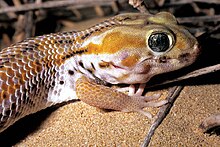Persian wonder gecko
| Persian wonder gecko | |
|---|---|

| |
| Teratoscincus keyserlingii | |
| Scientific classification | |
| Domain: | Eukaryota |
| Kingdom: | Animalia |
| Phylum: | Chordata |
| Class: | Reptilia |
| Order: | Squamata |
| Infraorder: | Gekkota |
| Family: | Sphaerodactylidae |
| Genus: | Teratoscincus |
| Species: | T. keyserlingii
|
| Binomial name | |
| Teratoscincus keyserlingii Strauch, 1863
| |
| Synonyms | |
The Persian wonder gecko (Teratoscincus keyserlingii), also known commonly as the giant frog-eyed gecko and Keyserling's wonder gecko, is a species of lizard in the family Sphaerodactylidae. The species is native to western Asia.
Etymology
[edit]The specific name, keyserlingii, is in honor of Alexander von Keyserling, who was a Baltic German geologist and biologist.[2]
Geographic range
[edit]T. keyserlingii is found in Afghanistan, Iran, Pakistan, and the United Arab Emirates.[3]
Habitat
[edit]The preferred natural habitat of T. keyserlingii is desert, at altitudes from sea level to 1,500 m (4,900 ft).[1]
Description
[edit]The holotype of T. keyserlingii has a total length of 15.8 cm (6.2 in), which includes a tail 5.6 cm (2.2 in) long.[4]
Behavior
[edit]T. keyserlingii is terrestrial and nocturnal.[1]
Reproduction
[edit]T. keyserlingii is oviparous.[1][3]
References
[edit]- ^ a b c d Els J, Gardner A, Carranza S, Soorae P, Papenfuss T, Shafiei Bafti S (2019). "Teratoscincus keyserlingii ". The IUCN Red List of Threatened Species 2019: https://dx.doi.org/10.2305/IUCN.UK.2019-2.RLTS.T164620A1062064.en. Accessed on 24 August 2024.
- ^ Beolens, Bo; Watkins, Michael; Grayson, Michael (2011). The Eponym Dictionary of Reptiles. Baltimore: Johns Hopkins University Press. xiii + 296 pp. ISBN 978-1-4214-0135-5. (Teratoscincus keyserlingii, p. 140).
- ^ a b Teratoscincus keyserlingii at the Reptarium.cz Reptile Database. Accessed 24 February 2019.
- ^ Strauch (1863).
Further reading
[edit]- Macey, J. Robert; Fong, Jonathan J.; Keuhl, Jennifer V.; Shafiei, Soheila; Ananjeva, Natalia B.; Papenfuss, Theodore J.; Boore, Jeffrey L. (2005). "The complete mitochondrial genome of a gecko and the phylogenetic position of the Middle Eastern Teratoscincus keyserlingii ". Molecular Phylogenetics and Evolution 36: 188–193.
- Sindaco R, Jeremčenko VK (2008). The Reptiles of the Western Palearctic. 1. Annotated Checklist and Distributional Atlas of the Turtles, Crocodiles, Amphisbaenians and Lizards of Europe, North Africa, Middle East and Central Asia. (Monographs of the Societas Herpetologica Italica). Latina, Italy: Edizioni Belvedere. 580 pp. ISBN 978-88-89504-14-7.
- Strauch A (1863). "Characteristik zweier neuen Eidechsen aus Persien ". Bulletin de l'Académie Impériale des Sciences de St-Pétersbourg 6: 477–480. (Teratoscincus keyserlingii, new species, p. 480). (in German and Latin).
- Tamar K, Els J, Kornilios P, Soorae P, Tarroso P, Thanou E et al. [16 authors] (2021). "The demise of a wonder: Evolutionary history and conservation assessments of the Wonder Gecko Teratoscincus keyserlingii (Gekkota, Sphaerodactylidae) in Arabia". PLoS ONE 16 (1): e0244150.

